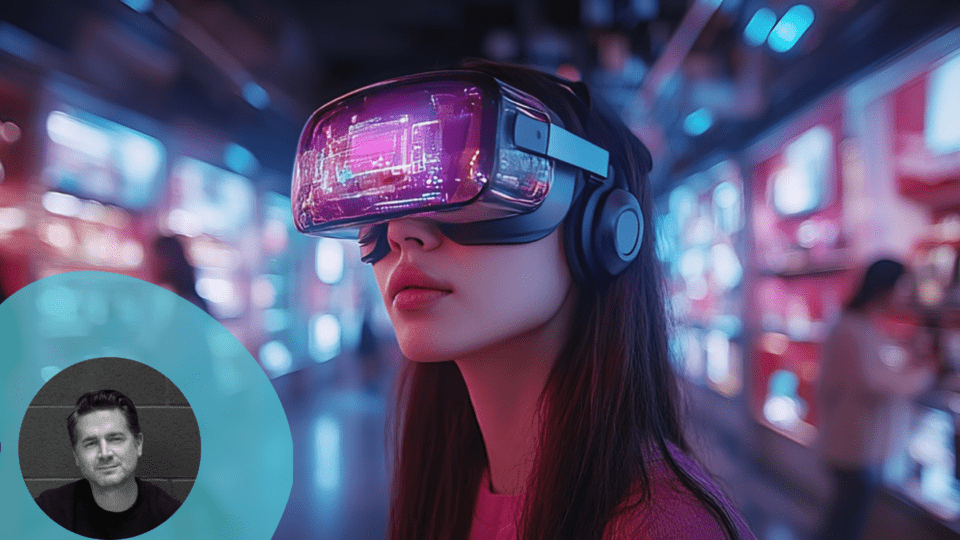There’s a lot retailers can learn from the success of immersive location-based entertainment spaces this past year. The Sphere in Las Vegas reimagined concertgoing, giving music lovers 360 degrees of eye-popping real-time visuals synced to music; Meow Wolf has reimagined museum visits; and Hollywood is taking its first stab at immersing fans in their favorite shows with Netflix Houses – built in post-COVID available retail spaces in malls.
The thrill and the draw of immersive entertainment is nothing new. From national parks to theme parks, people have long loved the lure of being transported into different worlds. And with each new technological advancement, what’s possible for immersion changes. We are now at one of those moments of new possibilities.
New technologies like self-contained XR wearables, spatial technology and projection technology are providing opportunities to entertain and delight shoppers in brand new ways. We’re now seeing retailers leverage the power of immersive technology to reimagine and reinvigorate in-person retailing.
Just imagine the possibilities – wall to wall digital surfaces, instantly re-skinnable and interactive, and next-generation digital mirrors that allow viewers to try on their physical items, twinned with their digital product counterparts. This applies as easily to fashion and automotive just as it does to lifestyle, cooking and entertainment. The possibilities are endless.
Advertisement
Truly immersive experiences within the retail environment are more possible today than ever before, but producing them requires a mindset shift. Young and old, rural and urban, tech savvy and tech-scared – we are seeing evidence steadily building that consumers are ready for new experiences. They are looking to be inspired and are hungry for participatory content in which they can interact with friends and co-create within it. Here’s a look at what factors to consider in order to gain support and make it successful:
Return on investment. Retail buyers have to justify the return on investment for the real estate each brand occupies in-store. The addition of immersive experiences is one way to boost engagement with customers, increase length of time in store, and ultimately boost ROI. In London, Future Stores will be testing out this theory with the opening of Future Stores on Oxford Street. The retail concept uses LED screens and generative AI to create a constantly evolving space designed for the needs of the TikTok generation. It will combine the immersive entertainment with technology that tracks footfall and “linger time” to evaluate its performance. Retailers can look to existing immersive experiences and how they are leveraging immersive spaces for retail opportunities. For instance, the traveling Messi Experience, which allows fans to “step into the world of Leo Messi”. concludes with a retail store.
Extending Brand Loyalty. Hasbro’s Monopoly Life Sized experience in England is a spectacular example of participatory content for a consumer product that typically engages with fans at point of purchase only, and perhaps only once in a lifetime. The interactive larger than life (truly) board game experience that lets fans walk through streets and buy properties appeals to young and old, bridging the generation gap but, more importantly, bringing the classic board game into the modern era in a new, engaging way. Its massive engagement is a model for other brands turning to immersive experiences to boost brand awareness and loyalty.
Making it Fun. The stars of the Olympics were certainly the athletes, but advanced technology played a supporting role outside the events that brought fun and games to the Summer Games. Around the city, Google used AR to give visitors an opportunity to witness Parisian landmarks come to life with time lapse animations. Meanwhile, the athletes had a chance to partake in the immersive content with activations in the athlete’s village. To share just one example, Snap partnered with Coca-Cola on what was called the world’s first AR-powered vending machine. More than just a soda machine, it used advanced body tracking so users could virtually try on merchandise and play with Snap’s top trending lenses. With this technology, Snap and Coca-Cola took an old fashioned static machine and turned it into a portable, virtual playground and a hot attraction in the athlete’s village.
With the arrival of wearables like the Apple Pro Vision, the Meta Ray-Ban frames, the Meta Quest and the HTC Focus Vision – paired with 8k LED screens and dome projections — a new era of immersive entertainment is upon us. The latest generative AI tools can help brands create even more engaging experiences by personalizing them for customers. By analyzing customer data and generating personalized content, immersive experiences go from a generic engaging experience to personalized relevant experience, further enhancing brand engagement.
While the tools and technology are here, ultimately the most compelling immersive experiences will not only leverage the latest technology but will engage and transform customers into loyal fans. Brands on the front lines of consumer interaction need to make each interaction memorable and impactful. It’s tougher than ever to break through the noise of social media content and product launches, but with these new immersive formats it’s possible to grab valuable attention and create new fans.
Tim Dillon has spent the past two decades exploring the front lines of interactive and immersive media, digital, experiential and emerging technologies. Prior to joining Wevr as EVP, Dillon was SVP Real-time and Virtual Worlds at Media Monks, a leading global brand agency focused on digital growth for clients including Hasbro, Disney, Pokémon, Nike, Verizon, Coca-Cola and many more.






